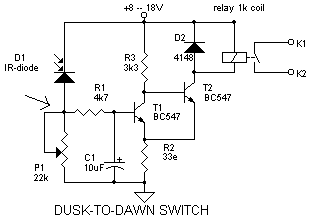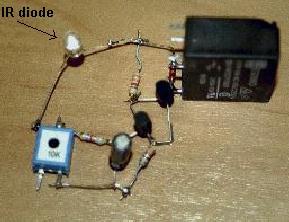 Dusk to dawn switch
Dusk to dawn switch

 Dusk to dawn switch
Dusk to dawn switch

Introduction
This dusk to dawn switch switches on the lamp at night and automatically switches off the lamp in daytime.
The circuit uses an old-fashioned relay as switching element which makes it suitable for all lamp types: not only
incandescent but also TL and compact fluorescent.
Circuit description
When it is light, infrared-diode D1 will be conducting; the voltage on the anode of D1 (see arrow) will be high.
A current will flow through R1 into the base of T1. Because T1 pulls down the base of T2 the relay is switched off.
In the dark, D1 will stop conducting; the voltage on the anode of D1 will become low.
Consequently the base current of T1 will decrease and current will flow into the base of T2 via R3: the relay is switched on.
-The light sensitivity can be adjusted wiith P1; lower resistance = more light necessary to switch off the relay.
-R2 creates some hysteresis to prevent fllickering at the circuit's trip level.
-C1 creates a low pass filter with R1, allso to prevent flickering and to decrease sensitivity to 50Hz hum.
-The trip-voltage on the anode of D1 (seee arrow) is about 1 Volt; below 1V the relay will switch on; above it will switch off.
-I used a LED-shaped IR diode; very conveenient for waterproof mounting in the lamp fixture.
-The circuit will also work with other liight sensors as photo diodes/transistors and LDR's. IR diodes have the advantage that
they are not very sensitive to light from TL or other fluorescent lamps which emit very little infrared !
Dusk to dawn switch schematic & picture of assembled circuit:


(who needs circuit boards anyway?)